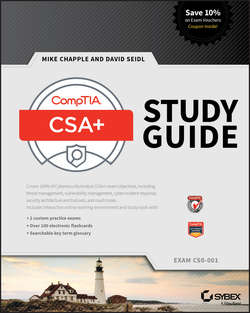Читать книгу CompTIA CSA+ Study Guide - Mike Chapple - Страница 17
На сайте Литреса книга снята с продажи.
Chapter 1
Defending Against Cybersecurity Threats
Penetration Testing
ОглавлениеIn addition to bearing responsibility for the design and implementation of security controls, cybersecurity analysts are responsible for monitoring the ongoing effectiveness of those controls. Penetration testing is one of the techniques they use to fulfill this obligation. During a penetration test, the testers simulate an attack against the organization using the same information, tools, and techniques available to real attackers. They seek to gain access to systems and information and then report their findings to management. The results of penetration tests may be used to bolster an organization’s security controls.
Penetration tests may be performed by an organization’s internal staff or by external consultants. In the case of internal tests, they require highly skilled individuals and are quite time-consuming. External tests mitigate these concerns but are often quite expensive to conduct. Despite these barriers to penetration tests, organizations should try to perform them periodically since a well-designed and well-executed penetration test is one of the best measures of an organization’s cybersecurity posture.
NIST divides penetration testing into the four phases shown in Figure 1.9.
Figure 1.9 NIST divides penetration testing into four phases.
Source: NIST SP 800-115: Technical Guide to Information Security Testing and Assessment
Planning a Penetration Test
The planning phase of a penetration test lays the administrative groundwork for the test. No technical work is performed during the planning phase, but it is a critical component of any penetration test. There are three important rules of engagement to finalize during the planning phase:
Timing When will the test take place? Will technology staff be informed of the test? Can it be timed to have as little impact on business operations as possible?
Scope What is the agreed-upon scope of the penetration test? Are any systems, networks, personnel, or business processes off-limits to the testers?
Authorization Who is authorizing the penetration test to take place? What should testers do if they are confronted by an employee or other individual who notices their suspicious activity?
These details are administrative in nature, but it is important to agree on them up front and in writing to avoid problems during and after the penetration test.
You should never conduct a penetration test without permission. Not only is an unauthorized test unethical, it may be illegal.
Conducting Discovery
The technical work of the penetration test begins during the discovery phase when attackers conduct reconnaissance and gather as much information as possible about the targeted network, systems, users, and applications. This may include conducting reviews of publicly available material, performing port scans of systems, using network vulnerability scanners and web application testers to probe for vulnerabilities, and performing other information gathering.
Vulnerability scanning is an important component of penetration testing. This topic is covered extensively in Chapters 3 and 4.
Executing a Penetration Test
During the attack phase, penetration testers seek to bypass the organization’s security controls and gain access to systems and applications run by the organization. Testers often follow the NIST attack process shown in Figure 1.10.
Figure 1.10 The attack phase of a penetration test uses a cyclical process that gains a foothold and then uses it to expand access within the target organization.
Source: NIST SP 800-115: Technical Guide to Information Security Testing and Assessment
In this process, attackers use the information gathered during the discovery phase to gain initial access to a system. Once they establish a foothold, they then seek to escalate their access until they gain complete administrative control of the system. From there, they can scan for additional system on the network, install additional penetration testing tools, and begin the cycle anew, seeking to expand their footprint within the targeted organization. They continue this cycle until they exhaust the possibilities or the time allotted for the test expires.
The attack phase of a penetration test is also known as the exploitation phase. Questions on the exam referring to test execution, the attack phase, and the exploitation phase are all referring to the same thing.
Communicating Penetration Test Results
At the conclusion of the penetration test, the testers prepare a detailed report communicating the access they were able to achieve and the vulnerabilities they exploited to gain this access. The results of penetration tests are valuable security planning tools, as they describe the actual vulnerabilities that an attacker might exploit to gain access to a network. Penetration testing reports typically contain detailed appendixes that include the results of various tests and may be shared with system administrators responsible for remediating issues.
Training and Exercises
In addition to performing penetration tests, some organizations choose to run wargame exercises that pit teams of security professionals against each other in a cyberdefense scenario. These exercises are typically performed in simulated environments, rather than on production networks, and seek to improve the skills of security professionals on both sides by exposing them to the tools and techniques used by attackers. Three teams are involved in most cybersecurity wargames:
● The red team plays the role of the attacker and uses reconnaissance and exploitation tools to attempt to gain access to the protected network. The red team’s work is similar to that of the testers during a penetration test.
● The blue team is responsible for securing the targeted environment and keeping the red team out by building, maintaining, and monitoring a comprehensive set of security controls.
● The white team coordinates the exercise and serves as referees, arbitrating disputes between the team, maintaining the technical environment, and monitoring the results.
Cybersecurity wargames can be an effective way to educate security professionals on modern attack and defense tactics.
